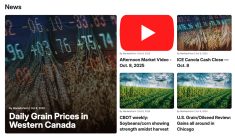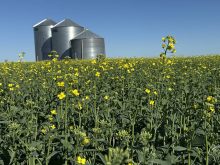Cattle prices up
Stronger fed cattle markets last week made up for the previous week’s price loss, said Canfax.
The price improvement was helped by light volumes early in the week, packers caught with short supply, the settled strike at the IBP Pasco, Wash., plant and current feedlots. United States cash fed cattle prices were steady to $1 (U.S.) stronger.
Alberta prices July 15 were steers $83.20-$85.35 per hundredweight, flat rail $143 and heifers $84.25, flat rail $143.65.
Canfax said producers must still be aware that basis swings could become more volatile and should be ready to sell on rallies. The outlook for this week was $1 per cwt. lower on fed cattle.
Read Also

Huge Black Sea flax crop to provide stiff competition
Russia and Kazakhstan harvested huge flax crops and will be providing stiff competition in China and the EU.
The Calgary beef market is steady to $1 higher on handyweights in a range of $142-$150. Canadian kill levels are more than 68,000 head with some packers working on Saturdays.
The year-to-date slaughter for 1999 is up eight percent in Canada and up 12 percent in Alberta alone.
Cows traded steady to $2 per cwt. higher. Cow volumes made up 90 percent of auction market sales.
Most D1,2 cows sold in a range of $55-$64, with sales to $66.25. Outlook is steady.
Feeder cattle sales were steady on few quotes. Buyers took a wait-and-see approach to the American duty situation, so the feeder market
hasn’t seen a price adjustment. Canfax said to expect steady sales as quality feeder cattle are in short supply.
Stock cow trade: Bred cows were $600-$1,000 on few quotes. Bred heifers were unquoted. Cow-calf pairs sold at $700-$1,525. Outlook is steady.
USDA released its July cattle-on-feed report July 16.
The number of cattle on feed is up four percent from last July 1. June placements were 15 percent above year-earlier levels and June marketings were up six percent in the seven major cattle feeding states.
Placements and marketings were above the average of trade predictions. The large marketings indicate feedlots are staying current, which is positive for cash prices.
Pork price rises, falls
Wholesale pork prices in the United States increased early last week, allowing packers to pay more for hogs, particularly where hot weather limited marketings.
Iowa-Southern Minnesota hog prices (51-52 percent lean, plant top, live equivalent) rose to $36.25 per cwt. (U.S.) at midweek.
By the end of the week, pork prices fell to encourage sales, but movement out of storage was not enough to reduce the large stocks.
On July 16, the Iowa-Southern Minnesota price was $25.50-36.50/cwt. with a mean of $33.57.
An increase in daily hog slaughter and lower market weights led some analysts to conclude liquidation is taking place, which could lower prices in the short term.
Glenn Grimes, of the University of Missouri, said in his analysis that although some think sow slaughter increased dramatically after the June hog and pig report, packing house data shows slaughter increased only slightly from the weeks leading up to the report and is actually lower than it was last year at this time
“Is it possible that after 20 consecutive months of losses, producers are expanding the breeding herd?” he asked.
















